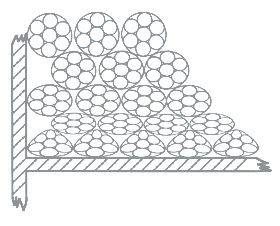Under normal operating conditions single wires will break due to material fatigue on the CROWN of a strand. ALL wire rope removal/retirement criteria are based on FATIGUE wire breaks located at the CROWN of a strand. (Click here for additional details.).
Crown and Valley Wire Breaks
CROWN Fatigue Breaks
|
|
 |
Remove the rope from service even if you find a SINGLE individual wire break which originates from inside of the rope. These so called VALLEY breaks have shown to be the cause for unexpected complete rope failures. |
VALLEY Wire Breaks
|
|
 A single valley wire break on a 19×7 rotation resistant rope. A single valley wire break on a 19×7 rotation resistant rope. |
 Condition of core under that same single valley break. Note the extreme notching of individual wire and the countless wire breaks. Such a condition is hidden under just a single (1) valley break! Condition of core under that same single valley break. Note the extreme notching of individual wire and the countless wire breaks. Such a condition is hidden under just a single (1) valley break! |
their typical ‘cup and cone’ appearance. |
 On the right and left a typical cut-and-cone break pattern. The wires in the center of the photo are a combination of fatigue and shear break. On the right and left a typical cut-and-cone break pattern. The wires in the center of the photo are a combination of fatigue and shear break. |
Lay Direction and Multiple Layer DamagesDamages caused by connection a right hand to a left hand lay rope |
|
|
These 3 picture show what happens when you connect a left-lay rope to a right-lay rope, as done with this boom pendant extension. Both ropes are opening up to the point where the strands are nearly parallel to each other; they completely untwisted themselves and developed excessive wire breaks. |
 |
Damages caused by multiple layer winding |
|
|
This is what happens when spooling on multiple layer drums was not properly tensioned. |
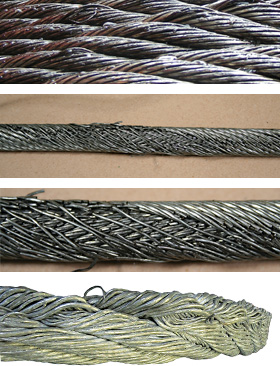 The result of such non-tensioning of the layers are looping of individual wires, completely crushed strands, total deterioration of a non-rotating rope due to gross neglect of inspection procedure. |
NOTE: For a more indepth discussion on wire rope discard and inspection we suggest to attend our “Wire Rope” and “SlingMax® Rigger’s Mortis Seminar”. Call 1.800.457.9997 for details and dates.




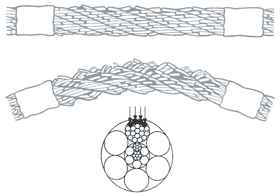


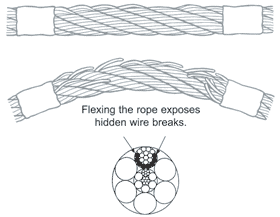

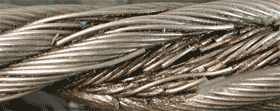 Valley breaks originate INSIDE the rope. Condition of the inner strands of the same rope as above. The core has completely failed and immenent catastrophic rope failure will be the result.
Valley breaks originate INSIDE the rope. Condition of the inner strands of the same rope as above. The core has completely failed and immenent catastrophic rope failure will be the result.